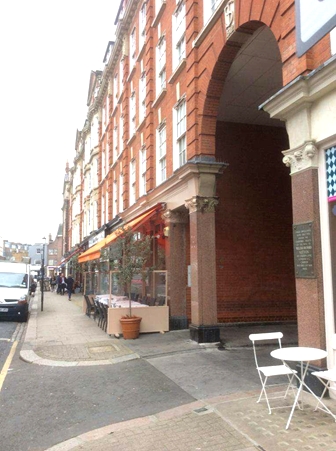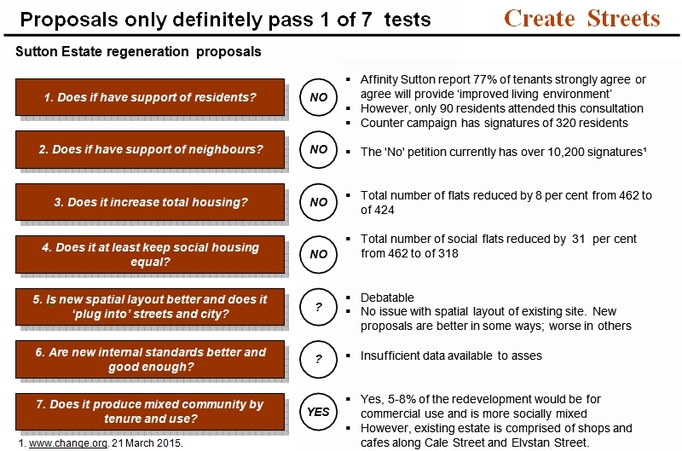The proposals for the Sutton Estate considered
A personal view by Flora Neville
Slotted neatly between the King's Road and the Fulham Road sits the Sutton Estate; uniform blocks of social housing, so structurally sound that even the blitz couldn't bring them down. In its heyday, this estate was exemplary of how social housing should be run. The red brick buildings with terra cotta details, and classical cornices match the Norman Shaw-built and inspired buildings of Kensington and Chelsea. 'The poor' were therefore not segregated to a ghetto, despite protestations from the rich, instead they made their homes in attractive buildings that overlooked St Luke's church, where Charles Dickens was married.
Fig i – The Sutton Estate1
There are many such red-brick social human-scale housing developments in Chelsea. More happily conceived, scaled and designed than their post-war descendents, these late Victorian or Edwardian philanthropic developments have, depending on their ownership history, either survived as social housing or, due to their attraction as homes, been at least in part ‘gentrified’. The Samuel Lewis Trust dwellings are right next door. Few are as elegantly detailed or well designed, however, as the Sutton Estate.
The buildings from which the residents are being decanted have certainly passed their optimum vintage. Paint is peeling away around the window frames, and damp is creeping in from the bottom up, and from the top down. Some of the apartments only have baths, no showers. Some of the residents believe the dilapidation levels are deliberate and that Affinity Sutton have created a stage set ruin by boarding up windows with rusty steel screens. The drains run into dips either side of the path, so the pavement is lower than the road, hence the damp. This would have been easily fixable. Through the key hole of a boarded up, deserted flat, I can see light streaming in to a spacious sitting room. Letters from years ago are strewn across the floor.
Structurally, the buildings are fundamentally in good shape. Francis Terry of Quinlan and Francis Terry Architects is so convinced by the architectural merit of the estate that he is considering drawing up an alternative scheme. The brickwork is ‘fantastic’, he says, and the terra cotta details would cost thousands today. The space between the blocks allows for a good amount of natural light and the buildings are medium rise.
However, Affinity Sutton propose to tear down the lot, (bar two listed blocks), and start again. This approach, they say, is the only way to combat the 'fundamental design problems.' These fundamental design problems include, 'narrow, dark and under-utilised strips of tarmac, a hotch-potch of sized units' tiny showers, swing doors between toilet and kitchen, no private space, no storage, bad sound insulation, damp, and Victorian plumbing. This is a little odd. It is hard to see how these 'fundamental’ problems are different from many of the necessary improvements to all old buildings, and pretty much all buildings in Chelsea very few of which would pass modern housing and building regulations but which, nevertheless, seem to be attractive, highly sought-after and very expensive homes. Meanwhile Pocket Homes are making a good living, and receiving GLA funding, to build precisely the sort of small flats that Affinity Sutton propose to knock down.
Affinity Sutton’s self-confident and assertive CEO, Keith Exford, also told Create Streets that the blocks did not have lifts. This leaves me wondering what the contraption was that elevated me from one floor to a higher one when I looked round the estate.
Fig iii – the new proposals are mixed use but lower density
However, the site does already have shops on it and, in other ways, the site will become less diverse. Two of the fifteen blocks, or 73 flats, are used for sheltered housing where elderly residents are helped by a warden, have a garden and a communal sitting room. I understand that there are no provisions for sheltered housing in Affinity Sutton's proposal.
Fig iv – It is good that the new scheme is to be mixed use but so is the existing scheme and it could very readily be made more so
Of course Affinity Sutton need to think financially. Without funds from the government, they need to make profits where they can in order to improve conditions for social residents and to build more social housing. Some renovation work is also undeniably necessary. 'We reject outright the allegation that redevelopment of the scheme is motivated by creating large profits,' says an Affinity Sutton spokesperson, and highlights that the charity has no legal obligation to re-home any of the existing clients on the estate, but that they are doing so because there is a lovely community, and they are against segregation.
However, Affinity Sutton's own facts and figures appear quietly incriminating. In the proposed plan, they will designate 318 homes for social rent and sell off 106 as (presumably luxury) private apartments. 106 is the absolute minimum number required to fund the redevelopment, Affinity Sutton assert. This might seem very reasonable except that the estate previously held 462 social homes. They are not just reducing the proportion of social units by over 30 per cent. Astonishingly, at a time of housing crisis, they are also reducing the overall density of the estate 8 per cent from 462, to 424.
Table i: number of Flats before Affinity Sutton merger and post development
Should Affinity Sutton be building more homes? Or renovating the site differently so as to keep more smaller flats? Affinity Sutton blame the Borough of Kensington and Chelsea for not permitting them. (I have not spoken to the borough about the site but the area certainly abounds in small flats and, as mentioned above, Pocket Homes is receiving GLA funding to build small so- called ‘one person’ flats in London).
No doubt the proposed scheme ‘works’ financially but, on the face of it, it seems very hard to accept that more modest, less ambitious internal regenerations would not permit the retention of a greater number of affordable units. This could have been funded by a more modest series of sell offs of additional units or perhaps an additional penthouse floor on a couple of blocks (they are only five storey). If Kensington and Chelsea does not need to maintain some sources of cheaper housing then where on God’s earth does? What is the right trade off between financial returns and social outcome?
Note: Affinity Sutton point out that the flats do not meet modern standards. However, this seem barely relevant as it is true of a very high percentage of historic homes in Chelsea or indeed anywhere else. The same rather surprising logic would demolish most listed buildings in the country and most of Kensington and Chelsea.
Things have got pretty bad. A senior Affinity Sutton spokesman made very personal allegations to Create Streets about one of the leaders of the Save Our Sutton group. Perhaps it is hardly surprising that many campaigners believe that some Registered Social Landlords have lost their moral compass. This might seems harsh but comedian Eddie Izzard has spoken out against Affinity Sutton's schemes and I understand that there is political nervousness about the scheme in some circles. Izzard believes this ‘should not be happening in the major cities of the world. London must fight hard to stop this happening.’ Izzard identifies diversity, equality and social concerns as a major part of London's identity. Perhaps along with a housing crisis, London is having an identity crisis. There must be a risk that, as elsewhere, foreign investors will deposit their fortunes in these 106 new flats and then leave them empty most of the time. Buy-to-Rent, Buy-to-Let, Buy-to-Launder? Would William Sutton have approved?
Table ii: analysis of Sutton Estate regeneration by Create Streets seven rules for good regeneration – it only definitely passes one of them from data available
Flora Neville is a journalist and has worked on the magazine, The Week and on The Mail. She is interested in the marginalization of communities; why that happens, the effects it has, and how that can be addressed through better housing and streets. She is writing a series of features on estate regeneration for Create Streets.







 RSS Feed
RSS Feed
